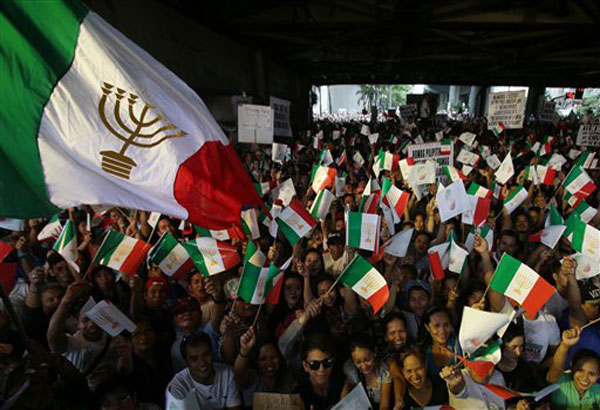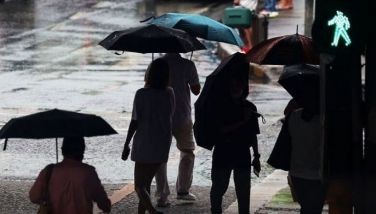Visiting New Orleans and the city of Austin

March 28, 2007 | 12:00am
NEW ORLEANS – One of the unexpected surprises my best friend Tony Rizarri had in store for me and my daughter Katrina while we’re in Houston, Texas was… he drove us for five and a half hours all the way to Louisiana and visit the famous city of New Orleans where we stayed overnight. Yes, I was bringing my daughter to New Orleans which almost two years ago suffered the worst disaster ever in the United States when Hurricane Katrina struck the Gulf of Mexico.
It was a special treat for us; after all, I have never been to New Orleans and yes, I wanted to see for myself how New Orleans has recovered a year or so after the hurricane destroyed it. We stayed at the Maison St. Charles Hotel, which was not in the flooded areas. If you’ve been to the United States, most of its cities look very much alike as Americans have a sort of common architecture with the exception of New York, Chicago, San Francisco and New Orleans. But New Orleans is one of its major centers of art and culture and yes, tourism is numero uno here.
You have to hand it to the people of New Orleans to turn one of the greatest natural disasters in the US (actually, many people do not blame Hurricane Katrina as to President Bush for not fixing the levee as money for it was transferred to the war effort in Iraq) into a major tourist industry. Today their stores carry colored photo documentaries of the disaster in a book entitled Katrina Revisited, The Great Deluge and Hurricane Katrina.
According to my friend Tony Rizarri, who’s been going to the Mardi Gras, most of New Orleans’ downtown district has already recovered. Only the homes that were flooded, owned mostly by poor black Americans, still remain destroyed or have not gotten repaired. While tourists go and see the homes ruined by Hurricane Katrina, I wasn’t interested in seeing them; after all, we get our share of super typhoons back home in the Philippines.
As we arrived near midnight, we walked over to Canal street and the famous Bourbon street. This is the famous French Quarter. The nightlife there was very much alive with young people, thanks to the spring break season. While Bourbon street was flooded, it was quickly refurbished and now life there is back to normal. There’s lots and lots of bars with people drinking on the street… and yes girls, girls, girls in their bars with signs that advertise "Bottomless and bottoms up… if you’re offended by this, you are not required to enter." New Orleans is one very Catholic city in the USA, but in Bourbon street sex is their religion!
New Orleans is also famous for Cajun or Creole cooking, which cannot be duplicated anywhere in America. I never liked the taste of Gumbo until I ate a bowl of it at the Market Café just behind the golden statue of St. Joan d’Arc given to the people of the United States by France. I also learned that New Orleans’ Cajun cuisine has its own lechon, which they call Cochon de Lait (koe sohn da lay) in French. They also have chicharon, which they call Cracklin. But since it’s crawfish season, we ate pounds and pounds of crawfish; this food you can only find in Texas or Louisiana.
Downtown New Orleans is a tourist spot, especially around the St. Louis Cathedral (this is just beside the Mississippi River) where you can tour the city in horse-drawn carriages. This is the only place in America where the streets reek of horseshit! It reminded me of how Colon street in Cebu City used to smell like. But to the tourists, the smell and architecture of New Orleans truly bring them back in time. New Orleans is like Vigan (only five times bigger) where old buildings are preserved and turned into tourist spots. Because most of downtown New Orleans is a tourist area, police are all over the place, so even if you meet drunks on the street, you know they won’t harm you. The police make sure that the tourists spend their money without them getting mugged.
The next day we took the same route on the way back to Houston, but since it was daytime, we were able to see the Atchafalaya Heritage area where the freeway goes in the middle of the wetlands. This is like the Candaba viaduct in Pampanga, except it is five times longer and the motorists are surrounded by wildlife. This is the only freeway where I saw an alligator ran over by motor vehicles.
We stopped by the State Wildlife Management Area information service and got all the brochures about America’s largest wetlands. One more thing I learned about Louisiana, all the counties are called parishes. So when you see a sign that says Iberville Parish, it is not really a parish in the sense of a Catholic Church parish… it is a county. This is the only state that calls its counties parishes.
The next day, we took a short ride to the city of Austin, the state capital of Texas, to see my big bike BMW buddy, Rogie Borromeo, and his wife Ditas and their kids. Austin has a state capitol that looked like the Capitol in Washington, D.C. Rogie drove us to his huge home, a lakeshore house beside the LBJ Lake in Granite Shoals, which he calls the Royal Oak Villa, which is now part of Texas Vacations as this place is truly a great recreation area. I also met his neighbor, Mitchell Stephen, who not only showed me his boat, but also his spanking new scoped caliber .17 Marlin rifle. We just stayed overnight and that was more than enough excuse for me to find time to return to Austin and visit Rogie again.
>I will be back in Manila by the middle of the week. Incidentally, I notice something about US Airlines, which is certainly of interest to our readers who are frequent flyers of domestic airlines. With US Airlines, upon landing, the pilot immediately gives his usual announcements about the details of the flight and then says, "You may now operate your cellphones and other electronic devices like iPods." They make this announcement while the aircraft is still barreling down the runway and slowing down to a crawl. Mind you, it is not only Continental Airlines doing this, I also heard the same report when we took America West from LAX to Vegas.
But in the Philippines, all airlines do not allow the use of cellphones until the aircraft has completely stopped and the plane doors are opened. Why is it like that? Who makes this decision for the airlines? Surely airline officials understand that the reason why cellphones are not allowed during a flight is because they may possibly interfere with the aircraft’s communication and navigations systems. Well, all that is not a problem anymore when the aircraft is on the ground and cellphones no longer pose a danger to the aircraft’s navigation system because even if they really do interfere with its navigation system, it won’t cause the plane to crash as it is already on the ground. So what gives?
For e-mail responses to this article, write to [email protected]. Bobit Avila’s columns can also be accessed through www.thefreeman.com. He also hosts a weekly talkshow, "Straight from the Sky," shown every Monday, 8 p.m., only in Metro Cebu on Channel 15 of SkyCable.
It was a special treat for us; after all, I have never been to New Orleans and yes, I wanted to see for myself how New Orleans has recovered a year or so after the hurricane destroyed it. We stayed at the Maison St. Charles Hotel, which was not in the flooded areas. If you’ve been to the United States, most of its cities look very much alike as Americans have a sort of common architecture with the exception of New York, Chicago, San Francisco and New Orleans. But New Orleans is one of its major centers of art and culture and yes, tourism is numero uno here.
You have to hand it to the people of New Orleans to turn one of the greatest natural disasters in the US (actually, many people do not blame Hurricane Katrina as to President Bush for not fixing the levee as money for it was transferred to the war effort in Iraq) into a major tourist industry. Today their stores carry colored photo documentaries of the disaster in a book entitled Katrina Revisited, The Great Deluge and Hurricane Katrina.
According to my friend Tony Rizarri, who’s been going to the Mardi Gras, most of New Orleans’ downtown district has already recovered. Only the homes that were flooded, owned mostly by poor black Americans, still remain destroyed or have not gotten repaired. While tourists go and see the homes ruined by Hurricane Katrina, I wasn’t interested in seeing them; after all, we get our share of super typhoons back home in the Philippines.
As we arrived near midnight, we walked over to Canal street and the famous Bourbon street. This is the famous French Quarter. The nightlife there was very much alive with young people, thanks to the spring break season. While Bourbon street was flooded, it was quickly refurbished and now life there is back to normal. There’s lots and lots of bars with people drinking on the street… and yes girls, girls, girls in their bars with signs that advertise "Bottomless and bottoms up… if you’re offended by this, you are not required to enter." New Orleans is one very Catholic city in the USA, but in Bourbon street sex is their religion!
New Orleans is also famous for Cajun or Creole cooking, which cannot be duplicated anywhere in America. I never liked the taste of Gumbo until I ate a bowl of it at the Market Café just behind the golden statue of St. Joan d’Arc given to the people of the United States by France. I also learned that New Orleans’ Cajun cuisine has its own lechon, which they call Cochon de Lait (koe sohn da lay) in French. They also have chicharon, which they call Cracklin. But since it’s crawfish season, we ate pounds and pounds of crawfish; this food you can only find in Texas or Louisiana.
Downtown New Orleans is a tourist spot, especially around the St. Louis Cathedral (this is just beside the Mississippi River) where you can tour the city in horse-drawn carriages. This is the only place in America where the streets reek of horseshit! It reminded me of how Colon street in Cebu City used to smell like. But to the tourists, the smell and architecture of New Orleans truly bring them back in time. New Orleans is like Vigan (only five times bigger) where old buildings are preserved and turned into tourist spots. Because most of downtown New Orleans is a tourist area, police are all over the place, so even if you meet drunks on the street, you know they won’t harm you. The police make sure that the tourists spend their money without them getting mugged.
The next day we took the same route on the way back to Houston, but since it was daytime, we were able to see the Atchafalaya Heritage area where the freeway goes in the middle of the wetlands. This is like the Candaba viaduct in Pampanga, except it is five times longer and the motorists are surrounded by wildlife. This is the only freeway where I saw an alligator ran over by motor vehicles.
We stopped by the State Wildlife Management Area information service and got all the brochures about America’s largest wetlands. One more thing I learned about Louisiana, all the counties are called parishes. So when you see a sign that says Iberville Parish, it is not really a parish in the sense of a Catholic Church parish… it is a county. This is the only state that calls its counties parishes.
The next day, we took a short ride to the city of Austin, the state capital of Texas, to see my big bike BMW buddy, Rogie Borromeo, and his wife Ditas and their kids. Austin has a state capitol that looked like the Capitol in Washington, D.C. Rogie drove us to his huge home, a lakeshore house beside the LBJ Lake in Granite Shoals, which he calls the Royal Oak Villa, which is now part of Texas Vacations as this place is truly a great recreation area. I also met his neighbor, Mitchell Stephen, who not only showed me his boat, but also his spanking new scoped caliber .17 Marlin rifle. We just stayed overnight and that was more than enough excuse for me to find time to return to Austin and visit Rogie again.
But in the Philippines, all airlines do not allow the use of cellphones until the aircraft has completely stopped and the plane doors are opened. Why is it like that? Who makes this decision for the airlines? Surely airline officials understand that the reason why cellphones are not allowed during a flight is because they may possibly interfere with the aircraft’s communication and navigations systems. Well, all that is not a problem anymore when the aircraft is on the ground and cellphones no longer pose a danger to the aircraft’s navigation system because even if they really do interfere with its navigation system, it won’t cause the plane to crash as it is already on the ground. So what gives?
BrandSpace Articles
<
>
- Latest
- Trending
Trending
Latest
Trending
Latest
Recommended






























